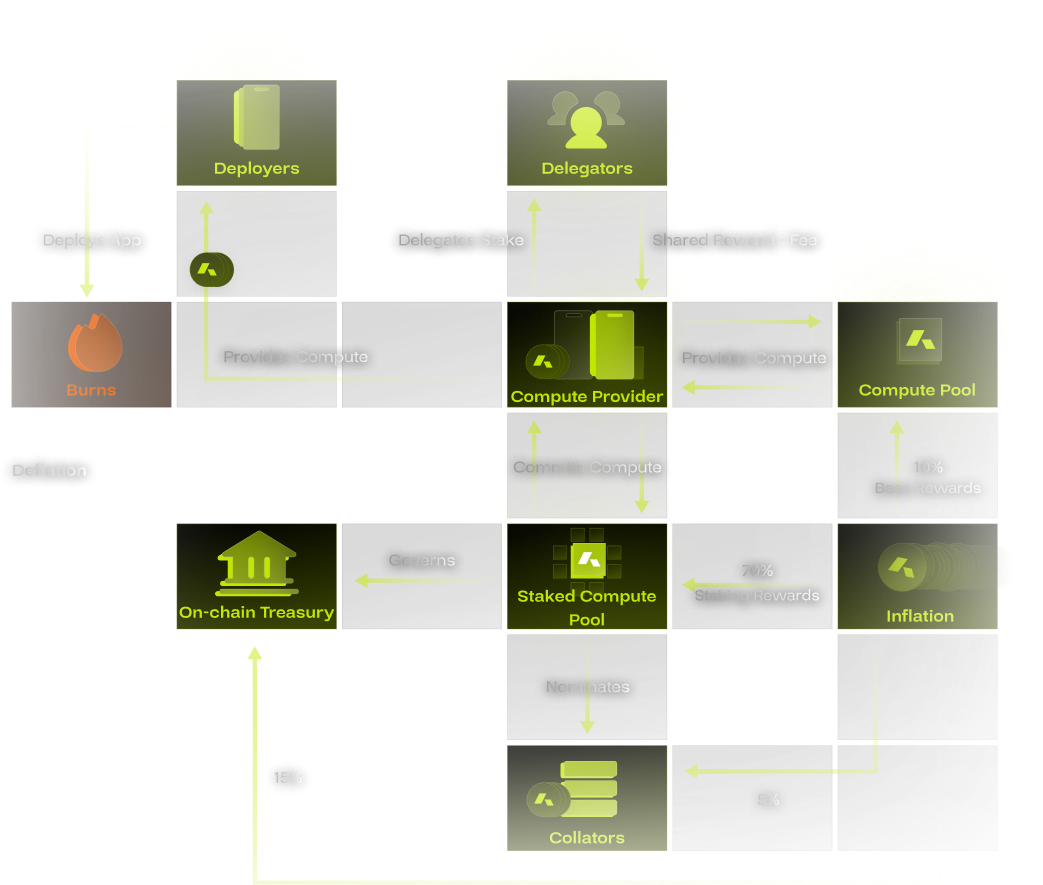커뮤니티
Acurast의 활기찬 커뮤니티의 일원이 되어보세요. 참여하고, 기여하고, 특별한 보상을 받을 수 있는 다양한 방법이 있습니다.
Acurast의 활기찬 커뮤니티의 일원이 되어보세요. 참여하고, 기여하고, 특별한 보상을 받을 수 있는 다양한 방법이 있습니다.
Acurast에 대해 알아보세요. 당사의 스토리를 살펴보고, 기술 문서를 살펴보고, 에코시스템의 파트너가 누구인지 알아보세요.
Acurast connects real phones with real incentives, turning smartphones into a global network of trusted compute.
Parameters may evolve. For details, see Documentation.
Parameters may evolve. For details, see Documentation.
STAKING WITH ACURAST
Developers who are building on Acurast compute seek high performance and rely on uninterrupted service. In decentralized networks, reliability can’t be assumed, it has to be proven. Staked Compute sets incentives for sustainable and continuing compute power. Providers contribute real phones; delegators reinforce them by staking their tokens.
The result is a network that stays active, is backed by accountability and ready to run workloads continuously.
How Staked Compute works
Providers (Committers) onboard their phones (*Lite or Core) and start providing compute. Delegators start with ACU they will be able to buy on an exchange once available.
*For staking the phone should be online 24/7 and ideally you have multiple phones.
Connect your phone in the Hub
Committers lock their tokens against a promised compute amount. Delegators choose a committer and lock their tokens to take part in their stake.
Stake Tokens
Benchmarks and heartbeats verify the staked compute amounts and liveness. Rewards are aligned according to performance, compute percentage, token amount and time. Delegators will get a share from the rewards from Committers.
Open Acurast Hub
Providers (Committers) onboard their phones (*Lite or Core) and start providing compute. Delegators start with ACU they will be able to buy on an exchange once available.
Connect your phone in the Hub*For staking the phone should be online 24/7 and ideally you have multiple phones.


Committers lock their tokens against a promised compute amount. Delegators choose a committer and lock their tokens to take part in their stake.
Stake TokensBenchmarks and heartbeats verify the staked compute amounts and liveness. Rewards are aligned according to performance, compute percentage, token amount and time. Delegators will get a share from the rewards from Committers.
Open Acurast Hub
Two roles, one network.

Provide real hardware (smartphones / farms).
Keep phones live and replace capacity as needed.
May add their own stake and can accpet delegations.
Share rewards with delegators.

Don’t run hardware; they contribute to a stake with their tokens.
Select committers and support reliable compute providers.
Get reward share from committers.
Can redelegate at any time
Reliability has value
Phone performance and uptime are verified on-chain. If a committer underdelivers their promised compute, their stake can be reduced, aligning incentives with accountability. When unstaking, a cooldown period slows reward accrual but responsibility to maintain committed compute remains until it ends. This keeps the network stable for everyone.
Reliability has value
Rewards are distributed each epoch and scale with three factors: committed compute, token amount and cooldown period.
Enable auto-compounding to keep rewards productive, restaking them automatically to sustain capacity.
Acurast Reward Formula
Committed Compute
Stake Amount
Cooldown period
Aligned incentives. Real Reliability.
Phones itself are not accountable, users are. Staked compute ensures network stability, holds providers accountable and rewards them if they stake and keep their promise.

Open the Acurast Hub, connect your wallet, and you are ready to onboard your first device.
Pair your phone. Benchmarks (CPU, RAM, Storage) run automatically and show the device’s capacity.
Committer: provide compute.
Delegator: select a committer and delegate tokens to support their reliability.
Enable auto-compound to restake earned rewards automatically each epoch.
Navigate to Staking and confirm your devices appear under “Current Compute.”
Make sure your device benchmarks look correct and your device is online.
Choose the amount of stake and the cooldown period you can maintain.
Longer cooldowns earn higher weight.
Enable delegations and set your fee if you want others to stake behind your device.
If a device goes offline, replace or offload it quickly to maintain rewards.
Navigate to Staking to browse available committers.
Check their uptime, compute score, track record, and delegation fee.
Select your tokens and a cooldown period that fits your timeline.
Turn it on to automatically restake rewards each epoch.
You can redelegate anytime if you find a committer with better performance or reliability.
Network Parameters
Epoch cadence
900 blocks (~1.5h)
Reward source
Protocol inflation: 5% per year
70% to Staked Compute pool
Benchmark weights
RAM (0.4615), CPU single (0.2307), CPU multi (0.2307), Storage (0.0769)
슬래싱
Proportional stake reduction for underperforming. Maximum slash rate: 0.003424657534% of the stake per epoch
Mainnet vs Canary
Canary Cooldown: 6 hours to 48 days
Mainnet Cooldown: 28 days to 1344 days
Below are the most frequently asked questions.
When a stake is created, the Committer or Delegator chooses a cooldown length. The allowed range differs between networks: on Mainnet, cooldown periods range from 28 days to roughly 3.68 years, while on Canary, they range from 1 hour to 48 hours. When the user decides to unstake, they trigger the cooldown countdown. Only when the cooldown has ended can they withdraw their staked tokens. During cooldown, the reward weight and vote weight are reduced to 50% of the previous value. See the Mainnet vs. Canary comparison for exact block values.
The cooldown period protects the network from sudden losses of compute capacity. Without it, committers could instantly withdraw their stakes and shut down their hardware, leaving the network vulnerable to instability. The cooldown gives the network time to adjust and allows other providers to fill the gap. It also ensures that committers remain committed to their promise: during cooldown, they must continue maintaining their full committed compute (with full slashing risk) even though their rewards are reduced to 50%. This design discourages impulsive exits and rewards long-term commitment, which is essential for building a reliable, predictable compute network that developers and users can depend on.
Staking with Acurast follows a clear principle: higher commitment equals higher rewards, but also higher risk. Committers who commit more compute, stake larger amounts of tokens, and choose longer cooldown periods earn proportionally greater rewards – but they also face greater slashing penalties if they fail to maintain their committed compute levels. For example, committing 80% of your measured compute yields more rewards than committing 50%, but falling short on that 80% commitment results in larger slashing penalties. Delegators face a similar tradeoff: they can earn staking rewards without running hardware, but they share in their chosen committer’s slashing risk. The key is finding the right balance – commit what you can reliably maintain over the long term. Conservative commitments (lower compute percentage, shorter cooldown) offer lower rewards but also lower risk, while aggressive commitments maximize rewards but require consistent, reliable operation of your hardware.
Even though any stake is basically a separate committement for each of the four of the benchmark pools (CPUs, CPUm, RAM, Storage), the staking frontend only shows one slider for simplicity reasons. For example, if the Committer selects to stake 50% of the measured compute, his stake is a committment to keep up 50% of the compute per Benchmark Metric Pool. Means to upkeep 50% of the CPU Single Core Benchmark Metric, 50% of the CPU Multi Core Benchmark Metric, 50% of the RAM Benchmark Metric and 50% of the Storage Benchmark Metric over the lifetime of the stake.
The maximum a user can commit is capped at 80% of the currently total measured compute, in order to prevent early Slashings if the Committer’s Compute is fluctuating due to processors going offline.
When a user stakes tokens, all of these tokens will be locked and cannot be moved. This means that the users account won’t be able to pay for gas fees caused by processors to report heartbeats and deployment execution reports. This would result in a situation where this account won’t be able to receive rewards from benchmarks or computation without getting additional tokens. Therefore a safeguard deposit of 1 cACU / ACU was introduced.
A committer can stake as much as they want up to the limit defined by their compute metric × the allowed ratio. The higher their benchmark (more or stronger devices), the more stake they can back it with. The committer’s own stake cannot exceed some multiple of their compute metric capacity (benchmark score). This prevents someone from locking an enormous amount of ACU behind a tiny phone and unfairly capturing rewards.
Staking rewards in the Acurast network are dynamic and cannot be precisely predicted in advance, as they depend on the collective behavior of all participants. Your individual rewards are determined by your share of the total network commitmen – calculated from your benchmark scores, stake size, and cooldown duration relative to all other stakers. As more participants join with varying parameters, or as existing participants adjust their commitments, the reward distribution shifts accordingly. Additionally, rewards are split across four separate benchmark metric pools, meaning your performance in each metric directly impacts your share of that pool’s rewards.
Once the system goes live and staking activity stabilizes, estimated Annual Percentage Rates (APR) will become available to help participants gauge potential returns. However, the fundamental principle remains: stronger hardware, larger stakes, and longer commitment periods will always yield proportionally higher rewards compared to participants with lower commitment levels.